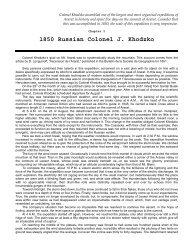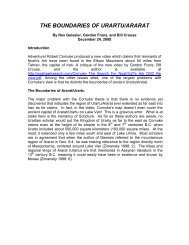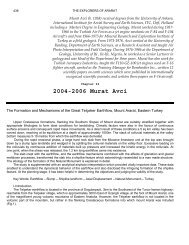The Formation and Mechanics of the Great Telceker Earth Flow
The Formation and Mechanics of the Great Telceker Earth Flow
The Formation and Mechanics of the Great Telceker Earth Flow
Create successful ePaper yourself
Turn your PDF publications into a flip-book with our unique Google optimized e-Paper software.
intercalated Eocene series. <strong>The</strong> harder layers are varied in thickness (maximum 50cm) <strong>and</strong> embrittled<br />
by faulting <strong>and</strong> folding. <strong>The</strong>y are easily removed <strong>and</strong> transported by external forces <strong>and</strong> thus provide<br />
<strong>the</strong> greater part <strong>of</strong> <strong>the</strong> earthflow materials. With its high clay content, this unit played an important role<br />
in <strong>the</strong> formation <strong>of</strong> <strong>the</strong> great earthflow by lubricating <strong>the</strong> colluvial materials when collaborated with<br />
water.<br />
<strong>The</strong> youngest <strong>and</strong> <strong>the</strong> highest rock unit is <strong>the</strong> 4-5m. Thick Miocene fossiliferous limestones overlying<br />
<strong>the</strong> easily removed s<strong>of</strong>t Eocene layers. This unit is horizontal or slightly tilted <strong>and</strong> broken into heavy<br />
blocks. This stratification creates a high degree <strong>of</strong> instability. Water seeps through <strong>the</strong> joints <strong>and</strong><br />
reaches <strong>the</strong> s<strong>of</strong>t, clayey Eocene layer, which <strong>the</strong>n causes <strong>the</strong> blocks to be moved down by slides, falls<br />
<strong>and</strong> slumps. Limestone blocks are <strong>the</strong> heaviest component <strong>of</strong> <strong>the</strong> colluvial deposit. <strong>The</strong> shiplike<br />
feature for example is a large block which detached from <strong>the</strong> sheer cliff <strong>of</strong> this unit by slumping.<br />
It is difficult to determine <strong>the</strong> interior lithology <strong>of</strong> <strong>the</strong> shiplike feature in <strong>the</strong> field, because during <strong>the</strong><br />
slumping <strong>and</strong> wedging process, it picket up many rock fragments from <strong>the</strong> colluvials. Enigün’s<br />
geophysical investigation (1988) did not yield significant information. Drilling at several strategic points<br />
would have allowed a clear look at <strong>the</strong> interior structure <strong>and</strong> material <strong>of</strong> <strong>the</strong> feature but this would be<br />
difficult <strong>and</strong> expensive. <strong>The</strong>re is a strong assumption that <strong>the</strong> shiplike feature is a block <strong>of</strong> layer from<br />
<strong>the</strong> Miocene limestone unit at <strong>the</strong> top as <strong>the</strong>re is no o<strong>the</strong>r thick <strong>and</strong> consolidated rock that could create<br />
such a l<strong>and</strong>form <strong>and</strong> withst<strong>and</strong> <strong>the</strong> hard erosive conditions prevailing in <strong>the</strong> area. On <strong>the</strong> o<strong>the</strong>r h<strong>and</strong>,<br />
from <strong>the</strong> engineering st<strong>and</strong>point, <strong>the</strong> important thing is <strong>the</strong> rigid rock slab which is <strong>the</strong> main factor to<br />
create a l<strong>and</strong>form such as this.<br />
<strong>The</strong> colluvial materials are loose Quaternary deposits derived from <strong>the</strong> surrounding rock units by<br />
means <strong>of</strong> different types <strong>of</strong> erosional processes <strong>and</strong> deposited at <strong>the</strong> valley floor up to a variable<br />
thickness <strong>of</strong> 5-10 metres. <strong>The</strong> great earthflow containing <strong>the</strong> shiplike feature is originated from this<br />
colluvials.<br />
Before <strong>the</strong> Telçeker earthflow took place, <strong>the</strong> whole area was covered by snow <strong>and</strong> <strong>the</strong>re was glacier<br />
formation until <strong>the</strong> late Quaternary. <strong>The</strong> higher areas such as <strong>the</strong> fossiliferous limestone at 2400m was<br />
covered by ice that did not melt even in warm seasons. Thus <strong>the</strong> shiplike l<strong>and</strong>form slumped down with<br />
glacier on its back. Repeated freez <strong>and</strong>-melt cycles during <strong>the</strong> seasons partially consolidated <strong>the</strong> loose<br />
colluvial materials by physical <strong>and</strong> chemical erosional processes <strong>and</strong> smoo<strong>the</strong>ned <strong>the</strong> topography <strong>of</strong><br />
<strong>the</strong> irregularly deposited colluvials in <strong>the</strong> basin. However, <strong>the</strong> topography <strong>of</strong> <strong>the</strong> younger earthflow is<br />
distinguishable from nonaffected areas by <strong>the</strong> anomalies created by sliding. Glacial l<strong>and</strong>forms such as<br />
glacier caves, cirque lakes <strong>and</strong> moraines are still visible in <strong>the</strong> area.<br />
III- Evolution <strong>of</strong> <strong>the</strong> Erosional Processes <strong>and</strong> <strong>Formation</strong> <strong>of</strong> <strong>the</strong> Telçeker <strong>Earth</strong>flow.<br />
A triangular valley is formed <strong>and</strong> enlarged by different erosional processes that work at <strong>the</strong> upper<br />
slopes <strong>and</strong> downcut at <strong>the</strong> only outlet <strong>of</strong> <strong>the</strong> triangle. While <strong>the</strong> valley was enlarging, <strong>the</strong> materials<br />
detached from <strong>the</strong> slopes were mainly accumulated in a thick colluvial layer on <strong>the</strong> valley floor ra<strong>the</strong>r<br />
than being transported away. <strong>The</strong>re are two reasons for this. First, <strong>the</strong>re is only one narrow outlet to<br />
<strong>the</strong> valley. Second, <strong>the</strong>re were frequent large l<strong>and</strong>slides because <strong>of</strong> climate, <strong>the</strong> rock types <strong>and</strong> <strong>the</strong>ir<br />
stratification.<br />
4









